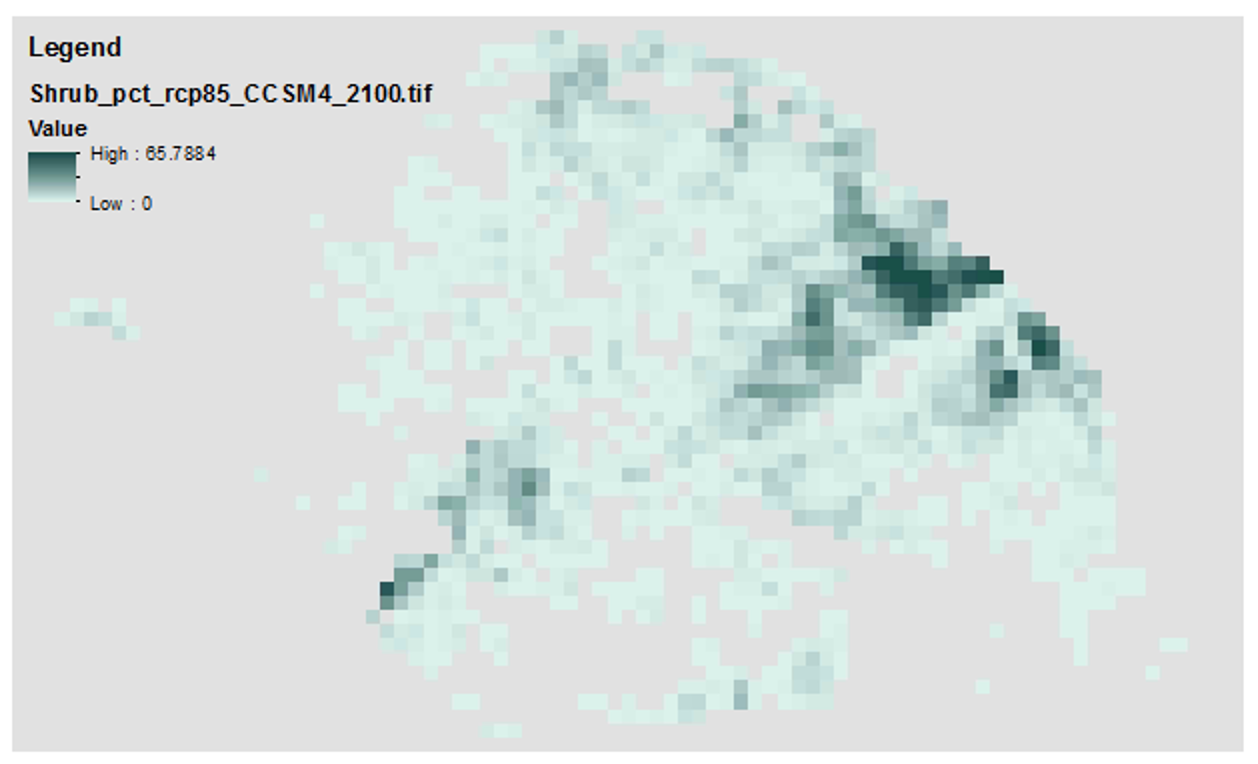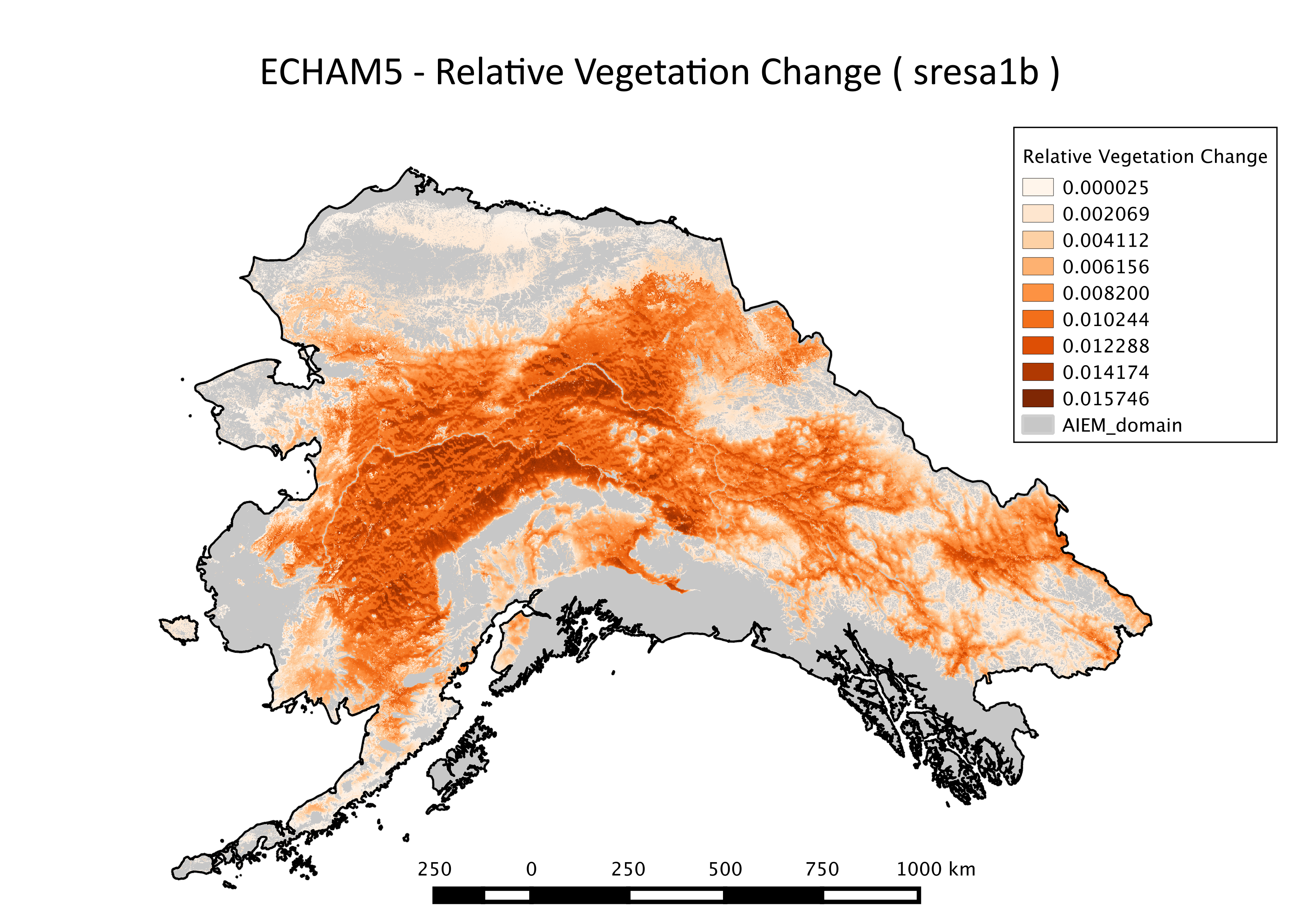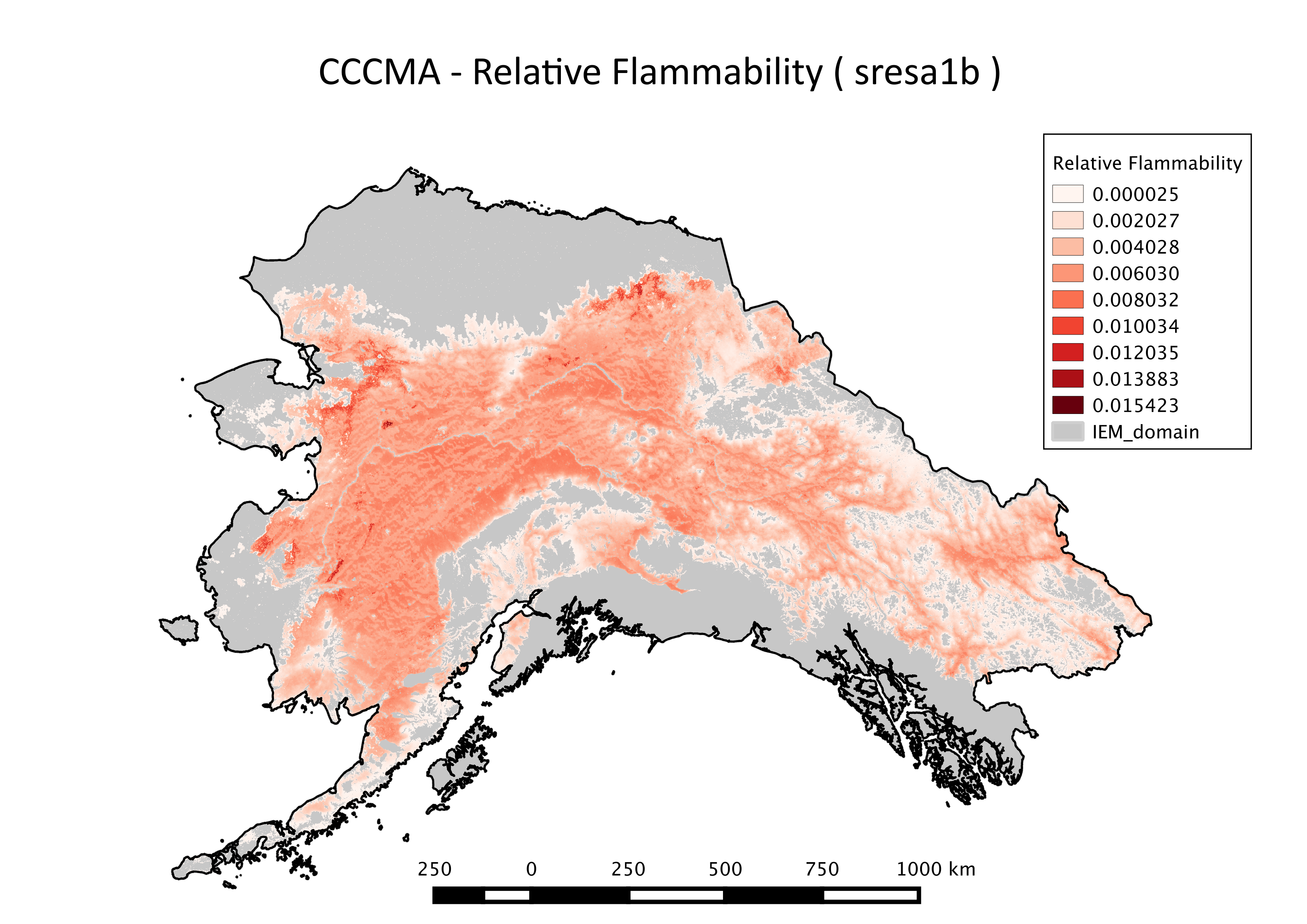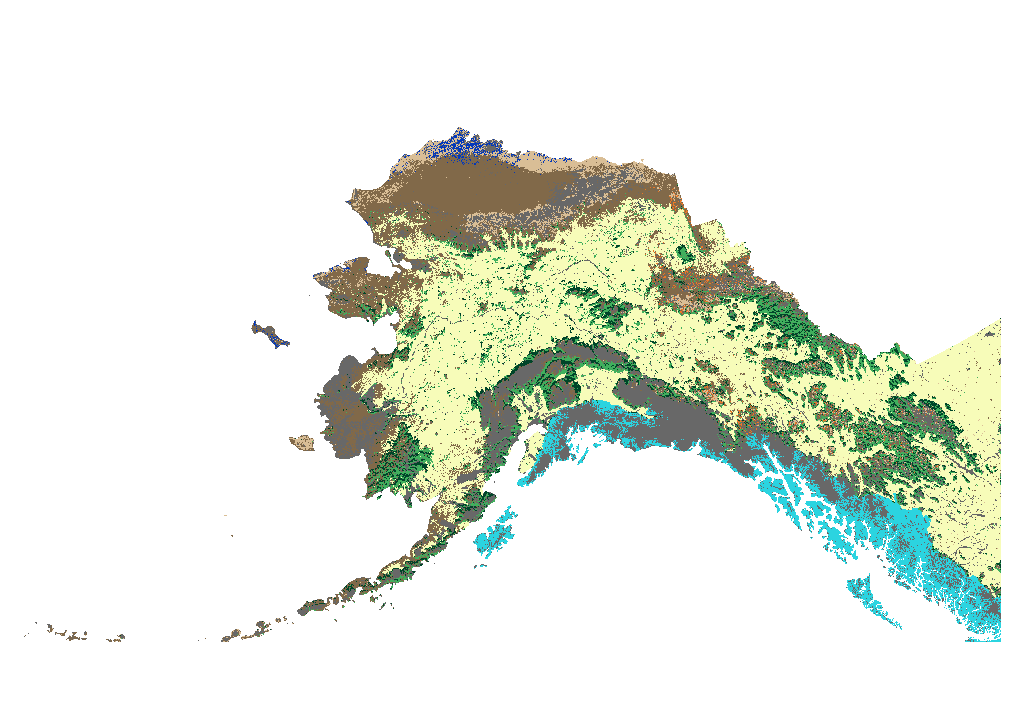1 km
Type of resources
Topics
Keywords
Contact for the resource
Provided by
Years
Formats
Representation types
Update frequencies
status
Resolution
-

These data contain historical and future projections of percent land cover from 1950 to 2100, as simulated by the Alaska Thermokarst Model for the boreal region. The data are 1km spatial resolution. The climate data used to drive the model simulations are from the Climate Research Unit, Time Series 4.0 (CRU_TS40) for the historical period (1950 to 2015), and from RCP 8.5 and global circulation models NCAR-CCSM4 and MRI-CGCM3 for the projected period (2016 to 2100). Datasets from the years 1950, 2000, 2050, and 2100 are provided. Annual maps are available upon request. Please note that this data is used to fill in a gap in available data for the Integrated Ecosystem Model (IEM) and does not constitute a complete or precise measurement of this variable in all locations. If used for publication, these data should be cited as the following: Genet H., Lara M., McGuire A.D., Jorgenson T.M., Euskirchen E.S., Clein J., Carman T., Rutter R., Rupp S., Breen A., Kurkowski T., Bennett A., Torgenson B., Romanovski V., Marchenko S. 2018. Land cover dynamic in the Tanana Flats from 1950 to 2100 driven by thermokarst activity.
-

This dataset consists of spatial representations of relative vegetation change produced through summarization of ALFRESCO model outputs. These specific outputs are from the Integrated Ecosystem Model (IEM) project, and are from the linear coupled version using AR5/CMIP5 climate inputs (IEM Generation 2).
-

This set of files includes downscaled historical estimates of monthly total precipitation (in millimeters) at 1 kilometer spatial resolution. Each file represents a single month in a given year. The original SNAP downscaled precipitation product at 2 kilometer spatial resolution was resampled to 1 kilometer spatial resolution via bilinear interpolation to create these data for input to the Integrated Ecosystem Model (IEM). Please note that this data is used to fill in a gap in available data for the IEM and does not constitute a complete or precise measurement of this variable in all locations.
-

This 1km land cover dataset represent highly modified output originating from the Alaska portion of the North American Land Change Monitoring System (NALCMS) 2005 dataset as well as the National Land Cover Dataset 2001. This model input dataset was developed solely for use in the ALFRESCO, TEM, GIPL and the combined Integrated Ecosystem Model landscape scale modeling studies and is not representative of any ground based observations. Use of this dataset in studies needing generalized land cover information are advised to utilize newer versions of original input datasets (2005 NALCMS 2.0, NLCD), as methods of classification have improved, including the correction of NALCMS classification errors. Original landcover data, including legends: NALCMS http://www.cec.org/north-american-land-change-monitoring-system/ NLCD 2001 https://www.mrlc.gov/data?f%5B0%5D=region%3Aalaska Final Legend: value | class name 0 | Not Modeled 1 | Black Spruce Forest 2 | White Spruce Forest 3 | Deciduous Forest 4 | Shrub Tundra 5 | Graminoid Tundra 6 | Wetland Tundra 7 | Barren lichen-moss 8 | Heath 9 | Maritime Upland Forest 10 | Maritime Forested Wetland 11 | Maritime Fen 12 | Maritime Alder Shrubland** Methods of production: Due to specific models' land cover input requirements, including the fact that each model is primarily focused on different descriptive aspects of land cover (i.e. ALFRESCO considers land cover in respect to how it burns, TEM considers land cover in respect to how it cycles carbon through the system, and GIPL considers land cover with respect to its influence on the insulative qualities of the soil).
-

This file includes spatial representations of relative flammability produced through summarization of the ALFRESCO model outputs. These specific outputs are from the Integrated Ecosystem Model (IEM) project, and are from the linear coupled version using AR5/CMIP5 climate inputs (IEM Generation 2). This dataset has been updated to include flammability data summarized over additional time scales as well, done in the same manner as the intial dataset. These ALFRESCO outputs were summarized over three future eras (2010-2039, 2040-2069, 2070-2099) and a historical era (1950-2008), for two future emissions scenarios for five CMIP5 models
-

These annual fire history grids (0=no fire, 1=fire) were produced directly from the BLM Alaska Fire Service database and the Canadian National Fire Database. They are simply a 1x1km raster representation of their fire history polygon database that can be obtained from: http://fire.ak.blm.gov/predsvcs/maps.php http://cwfis.cfs.nrcan.gc.ca/datamart Note, fire history data is very unreliable before ~1950 in Alaska. Fires may have been recorded in a given year, but that does not mean all fires that occurred were successfully recorded. This data was assembled from every recorded fire that has been entered into Alaska and Canadian databases. This results in several years containing no fires at all.
-

This dataset consists of 6000 GeoTIFFs produced by the Geophysical Institute Permafrost Lab (GIPL) Permafrost Model. Six distinct CMIP5 model-scenario combinations were used to force the GIPL model output. Each model-scenario combination includes annual (2021-2120) summaries of the following ten variables: - Mean Annual Ground Temperature (MAGT) at 0.5 m below the surface (°C) - MAGT at 1 m below the surface (°C) - MAGT at 2 m below the surface (°C) - MAGT at 3 m below the surface (°C) - MAGT at 4 m below the surface (°C) - MAGT at 5 m below the surface (°C) - Mean Annual Surface (i.e., 0.01 m depth) Temperature (°C) - Permafrost top (upper boundary of the permafrost, depth below the surface in m) - Permafrost base (lower boundary of the permafrost, depth below the surface in m) - Talik thickness (perennially unfrozen ground occurring in permafrost terrain, m) There are 1000 GeoTIFF files per model-scenario combination. The model-scenario combinations are: - GFDL-CM3, RCP 4.5 - GFDL-CM3, RCP 8.5 - NCAR-CCSM4, RCP 4.5 - NCAR-CCSM4, RCP 8.5 - A 5-Model (GFDL-CM3, NCAR-CCSM4, GISS-E2-R, IPSL-CM5A-LR, MRI-CGCM3) Average, RCP 8.5 - A 5-Model (GFDL-CM3, NCAR-CCSM4, GISS-E2-R, IPSL-CM5A-LR, MRI-CGCM3) Average, RCP 4.5 The file naming convention is `gipl_model_scenario_variable_year.tif` for example: `gipl_GFDL-CM3_rcp45_talikthickness_m_2090.tif` Each GeoTIFF uses the Alaska Albers (EPSG:3338) projection and has a spatial resolution of 1 km x 1 km. All rasters in this dataset have indentical extents, spatial references, and metadata objects. Once extracted, the entire dataset (all 6000 GeoTIFFs) requires 39 GB of disk space. Data are compressed into ten .zip files, one per variable. Each archive will contain all model-scenario combinations and all years for that variable. Each .zip file contains 600 GeoTIFFs. This research was funded by the Broad Agency Announcement Program and the U.S. Army Engineer Research and Development Center and Cold Regions Research and Engineering Laboratory (ERDC-CRREL) under Contract No. W913E521C0010. The GIPL2-MPI/GCM simulations were supported in part by the high-performance computing and data storage resources operated by the Research Computing Systems Group at the University of Alaska Fairbanks Geophysical Institute.
-

These GeoTIFFs include annual spatial representations of the following variables produced through summarization of ALFRESCO model outputs across 200 replicates: Flammability: likelihood of a pixel to burn across 200 replicates Modal vegetation type: statistical mode of vegetation type across 200 replicates Percent vegetation type: percent of each possible vegetation type across 200 replicates These outputs were derived from AR5/CMIP5 climate inputs, historical fire inputs from the Alaska Interagency Coordination Center (AICC), and several fire management options (FMO) inputs.
-
This dataset consists of spatial representations of vegetation types produced through summarization of ALFRESCO model outputs. These specific outputs are from the Integrated Ecosystem Model (IEM) project, AR5/CMIP5 climate inputs (IEM Generation 2). ALFRESCO outputs were summarized over three future eras (2010-2039, 2040-269, 2070-2099) and a historical era (1950-2008). Both the proportions of all possible vegetation types and the modal vegetation type (most common type over a given era) are available as sub-datasets. Each are summarized over two future emissions scenarios for five CMIP5 models.
 SNAP GeoNetwork
SNAP GeoNetwork